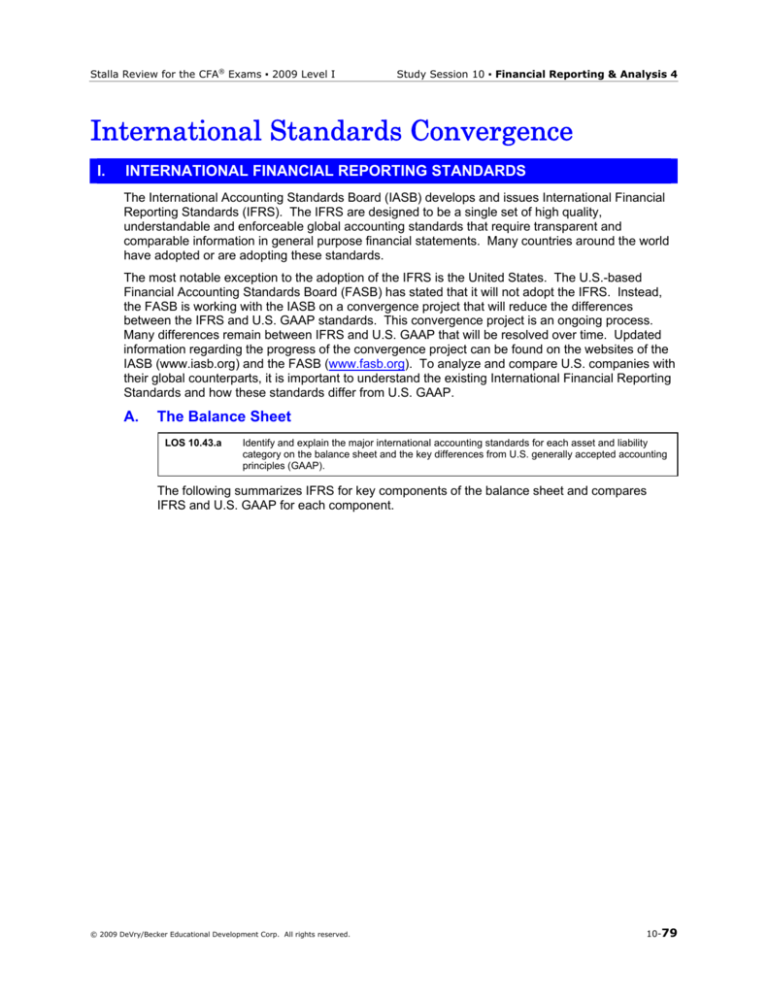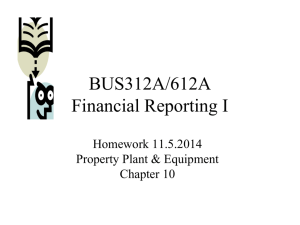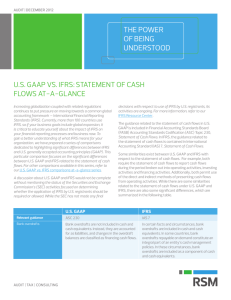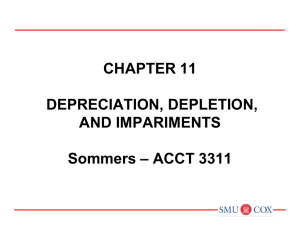
Stalla Review for the CFA® Exams ▪ 2009 Level I
Study Session 10 ▪ Financial Reporting & Analysis 4
International Standards Convergence
I.
INTERNATIONAL FINANCIAL REPORTING STANDARDS
The International Accounting Standards Board (IASB) develops and issues International Financial
Reporting Standards (IFRS). The IFRS are designed to be a single set of high quality,
understandable and enforceable global accounting standards that require transparent and
comparable information in general purpose financial statements. Many countries around the world
have adopted or are adopting these standards.
The most notable exception to the adoption of the IFRS is the United States. The U.S.-based
Financial Accounting Standards Board (FASB) has stated that it will not adopt the IFRS. Instead,
the FASB is working with the IASB on a convergence project that will reduce the differences
between the IFRS and U.S. GAAP standards. This convergence project is an ongoing process.
Many differences remain between IFRS and U.S. GAAP that will be resolved over time. Updated
information regarding the progress of the convergence project can be found on the websites of the
IASB (www.iasb.org) and the FASB (www.fasb.org). To analyze and compare U.S. companies with
their global counterparts, it is important to understand the existing International Financial Reporting
Standards and how these standards differ from U.S. GAAP.
A.
The Balance Sheet
LOS 10.43.a
Identify and explain the major international accounting standards for each asset and liability
category on the balance sheet and the key differences from U.S. generally accepted accounting
principles (GAAP).
The following summarizes IFRS for key components of the balance sheet and compares
IFRS and U.S. GAAP for each component.
© 2009 DeVry/Becker Educational Development Corp. All rights reserved.
10-79
Stalla Review for the CFA® Exams ▪ 2009 Level I
Financial Reporting & Analysis 4 ▪ Study Session 10
Comparison of IFRS and U.S. GAAP
Balance Sheet
Component
Marketable Securities
IFRS
U.S. GAAP
Marketable securities should initially be
recorded at fair value (generally the cost to
acquire the security). Subsequent
accounting for a marketable security
depends on its classification:
No significant differences from IFRS.
Although not discussed in the source
reading, under U.S. GAAP the unrealized
gains and losses on derivative
instruments are reported on the income
statement or as a "direct-to-equity"
adjustment in other comprehensive
income.
•
Held-to-maturity securities are reported
at amortized cost.
•
Held-for-trading securities, including
derivatives, are reported at fair value,
with unrealized gains and losses
reported on the income statement.
•
Available-for-sale securities are
reported at fair value, with unrealized
gains and losses reported in equity as a
component of other comprehensive
income.
Realized gains/losses and income (interest,
dividends) are reported on the income
statement for all marketable securities.
For all financial instruments, including
marketable securities, there must be
disclosures of credit risk, liquidity risk,
market risk, and risk management policies
and procedures.
Inventories
Property, Plant and
Equipment
10-80
Inventory must be reported at the lower of
cost or market. Inventory write-downs can
be reversed.
Inventory is reported at the lower of cost
or market. The reversal of inventory writedowns is prohibited.
The method selected should reflect the
order in which the products are sold, which
calls for using specific identification
whenever possible. Weighted average
cost or FIFO (first in, first out) are both
acceptable alternatives. The LIFO costing
method is prohibited.
The costing method is not required to
reflect the actual flow of the inventory.
The cost of inventory can be determined
using specific identification, weighted
average cost, FIFO or LIFO.
Fixed assets must be reported at cost less
accumulated depreciation or at a revalued
amount that reflects fair value of the asset
at the time of revaluation less subsequent
accumulated depreciation. Revaluation
gains are recorded as an increase to
equity, unless reversing a prior revaluation
decrease. Revaluation decreases are
reported on the income statement unless
reversing a prior revaluation increase.
Fixed assets are reported at cost less
accumulated depreciation. Revaluation is
not permitted, unless the asset is
determined to be impaired.
© 2009 DeVry/Becker Educational Development Corp. All rights reserved.
Stalla Review for the CFA® Exams ▪ 2009 Level I
Balance Sheet
Component
Study Session 10 ▪ Financial Reporting & Analysis 4
IFRS
Less than 20% ownership (no significant
influence) – Account for the investment as
a trading or available-for-sale security.
Long-Term
Investments
Between 20-50% ownership (significant
influence) – Account for the investment
using the equity method.
Greater than 50% ownership (control) –
Consolidation.
U.S. GAAP
Similar accounting rules, with the addition
that the method used to account for the
investment can also be based on the
economic substance of the relationship
between the investor and the investee
(not just the extent of voting control).
Also, the equity method is generally
required when joint control exists, while
proportionate consolidation is prohibited.
Joint control – Proportionate consolidation
is the preferred method; the equity method
is allowed.
Business
Combinations
Goodwill
Accounted for using the purchase method.
The assets and liabilities of the acquired
company are consolidated with the parent
company at their fair values on the date of
acquisition. The income statements and
statements of cash flows of the parent and
the acquired company are consolidated
from the date of acquisition forward.
No significant differences from IFRS. The
accounting for purchase method business
combinations is currently being reviewed
jointly by the FASB and IASB.
Goodwill is the difference between the
amount paid to acquire another company
and the fair value of the net assets of the
company acquired. Positive goodwill is
considered to be an unidentifiable
intangible asset because it cannot be
bought and sold individually. Negative
goodwill is reported as a gain in the period
of the business acquisition after
reassessing the acquisition cost and the
fair values of the acquired entity's assets
and liabilities.
No significant differences from IFRS,
although different terminology is used to
describe the process of determining
whether goodwill is impaired.
Goodwill must be tested annually for
impairment. Impairment losses are
reported on the income statement.
© 2009 DeVry/Becker Educational Development Corp. All rights reserved.
10-81
Financial Reporting & Analysis 4 ▪ Study Session 10
Balance Sheet
Component
Intangible Assets
Other Than Goodwill
Stalla Review for the CFA® Exams ▪ 2009 Level I
IFRS
U.S. GAAP
Identifiable intangible assets are defined as
arising from contractual or legal rights, or
capable of being separated from the
company and sold. Identifiable intangible
assets are recorded at cost when the cost
can be measured and it is probable that
future economic benefits from the asset will
flow to the company. Purchased or
manufactured intangibles are recognized
as assets while internally developed
intangibles are not.
Finite life intangible assets are reported at
cost less amortization and impairment.
Indefinite life intangibles are reported at
cost less impairment. Upward revaluation
to fair value is not permitted.
Finite life intangibles are amortized over
their useful lives. Indefinite life intangibles
are not amortized, but are evaluated at
least annually for impairment.
Intangibles can be reported on the balance
sheet at cost less amortization and
impairment, or at a revalued amount equal
to the fair value of the asset on the
revaluation date less subsequent
amortization. Revaluation increases are
recorded as a component of equity, unless
reversing a revaluation decrease.
Revaluation decreases are reported on the
income statement unless reversing a
revaluation increase.
Provisions (Nonfinancial liabilities)
10-82
Liabilities of uncertain timing or amount,
including warranty obligations and
contingent liabilities, are recognized when
there is a present obligation resulting from
a past event and the cost to settle the
obligation can be reasonably estimated.
The amount recognized is the best
estimate (as of the balance sheet date) of
the amount to settle the obligation.
Although not described in the source
reading, contingent liabilities are
recognized on the balance sheet when it
is probable that an asset has been
impaired or a liability incurred and the
amount of the loss can be reasonably
estimated.
© 2009 DeVry/Becker Educational Development Corp. All rights reserved.
Stalla Review for the CFA® Exams ▪ 2009 Level I
B.
Study Session 10 ▪ Financial Reporting & Analysis 4
The Income Statement
LOS 10.43.b
Identify and explain the major international accounting standards for major revenue and
expense categories on the income statement, and the key differences from U.S. GAAP.
The following summarizes the IFRS for key components of the income statement and
compares IFRS and U.S. GAAP for each component.
Comparison of IFRS and U.S. GAAP
Income Statement
Component
Revenue Recognition:
General
IFRS
U.S. GAAP
Income is defined as both revenues and
gains. Revenues are inflows of economic
benefits during the period from the ordinary
course of business or increases in equity
other than contributions from owners.
The key principles are the same, although
the following differences exist:
•
U.S. GAAP defines revenues in terms
of actual or expected cash flows.
Revenues are measured at the fair value of
the consideration received. Revenues are
recognized when:
•
Revenue recognition focuses on
realization and whether the revenue
has been earned.
•
It is possible to measure the amount of
revenue and the costs of the
transactions.
•
It is probable that economic benefits of
the transaction will flow to the seller.
•
To recognize revenue from the sale of
goods, the risks and rewards of
ownership must pass to the buyer and
the seller must not retain control of the
goods.
•
To recognize revenue from the sale of
services, the stage of completion of the
service must be reliably measured.
Two methods are available to account for
construction contracts:
•
When the outcome of the project can be
reasonably estimated, the percentage
of completion method is used.
•
When the outcome of the project cannot
be reasonably estimated, revenue is
recognized to the extent that it is
probable to recover costs.
Revenue Recognition:
Construction Contracts
The percentage of completion method is
used when the outcome of the project can
be reasonably estimated.
When the outcome cannot be reasonably
estimated, the completed contract method
is used with no revenue or expense
recognition until the project is completed
(assuming that a profit is expected).
Cost of Sales
The cost of inventory sold is calculated
using specific identification (preferred
method), weighted average cost or the
FIFO method. The LIFO method is
prohibited.
The cost of inventory sold is calculated
using specific identification, weighted
average cost, FIFO or LIFO.
Administrative
Expenses
Expenses include losses because
expenses are defined as decreases in
economic benefits that decrease equity.
Expenses do not include losses because
expenses are defined as outflows that
relate to primary operations.
© 2009 DeVry/Becker Educational Development Corp. All rights reserved.
10-83
Stalla Review for the CFA® Exams ▪ 2009 Level I
Financial Reporting & Analysis 4 ▪ Study Session 10
Income Statement
Component
IFRS
Depreciation methods are not required to
match the expected pattern of asset
consumption.
Depreciation Expense
Depreciation methods must be reviewed
annually for appropriateness. A
depreciation method is appropriate only if it
reflects the pattern of consumption of the
asset. A change in depreciation method is
a change in accounting method that is
accounted for prospectively (going
forward).
Financing costs (interest) for acquisition,
construction or production of an asset that
will take a long time to complete can be
expensed in the period incurred or
capitalized and added to the cost of the
asset.
Financing costs (interest) for acquisition,
construction or production of an asset that
will take a long time to complete must be
capitalized and added to the cost of the
asset. Companies cannot expense such
costs in the period incurred.
Temporary differences between IFRS and
applicable tax law result in the recognition
of deferred tax assets and deferred tax
liabilities.
Temporary differences between U.S.
GAAP and applicable tax law result in the
recognition of deferred tax assets and
deferred tax liabilities.
Discontinued Operations:
Discontinued Operations:
Recorded when a business component is
held for sale or has been disposed of and
management has no continuing
involvement.
IFRS has aligned with U.S. GAAP as
described.
Accounting Changes:
Accounting Changes:
Changes in accounting methods are
accounted for retrospectively. Changes in
accounting estimates are accounted for
prospectively.
U.S. GAAP has aligned with IFRS.
Extraordinary Items:
Extraordinary Items:
Gains and losses cannot be classified as
extraordinary.
Gains and losses that are (material in
amount), unusual in nature, and
infrequent in occurrence are reported
separately from income from continuing
operations.
Finance Costs
Income Tax Expense
Nonrecurring Items
10-84
U.S. GAAP
© 2009 DeVry/Becker Educational Development Corp. All rights reserved.
Stalla Review for the CFA® Exams ▪ 2009 Level I
C.
Study Session 10 ▪ Financial Reporting & Analysis 4
The Statement of Cash Flows
LOS 10.43.c
Identify and explain the major differences between international and U.S. GAAP accounting
standards concerning the treatment of interest and dividends on the cash flow statement.
Both IFRS and U.S. GAAP require that a statement of cash flows be included in the financial
statements and that cash flows be classified as operating, investing or financing. IFRS and
U.S. GAAP differ in the classification of interest and dividends as indicated below.
Comparison of IFRS and U.S. GAAP
Cash Flow
Component
Interest Received
Dividends Received
Interest Paid
Dividends Paid
IFRS
U.S. GAAP
Operating activities or investing activities
Operating activities only
(CFO or CFI)
(CFO)
Operating activities or investing activities
Operating activities only
(CFO or CFI)
(CFO)
Operating activities or financing activities
Operating activities only
(CFO or CFF)
(CFO)
Operating activities or financing activities
Financing activities only
(CFO or CFF)
(CFF)
© 2009 DeVry/Becker Educational Development Corp. All rights reserved.
10-85









